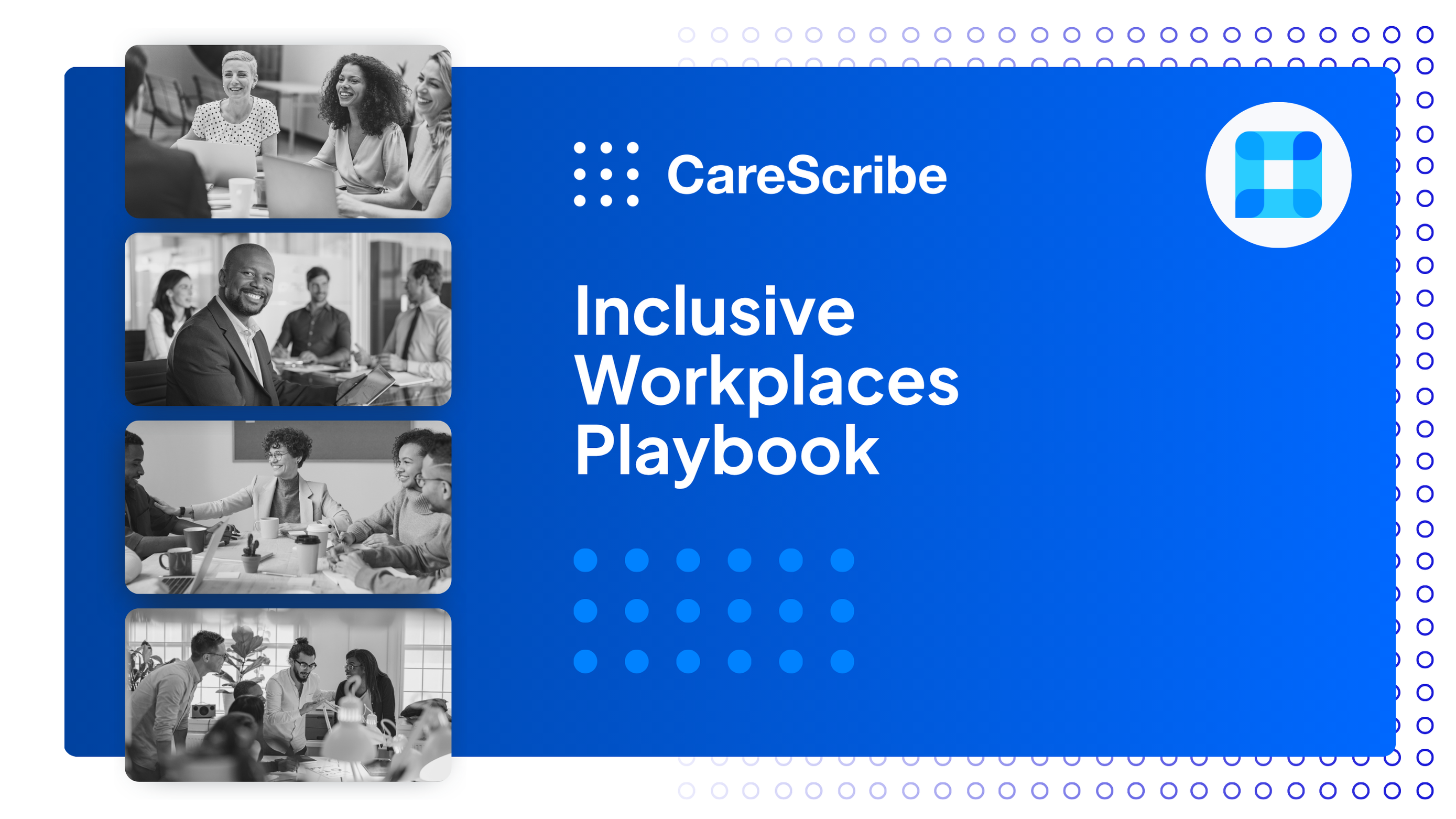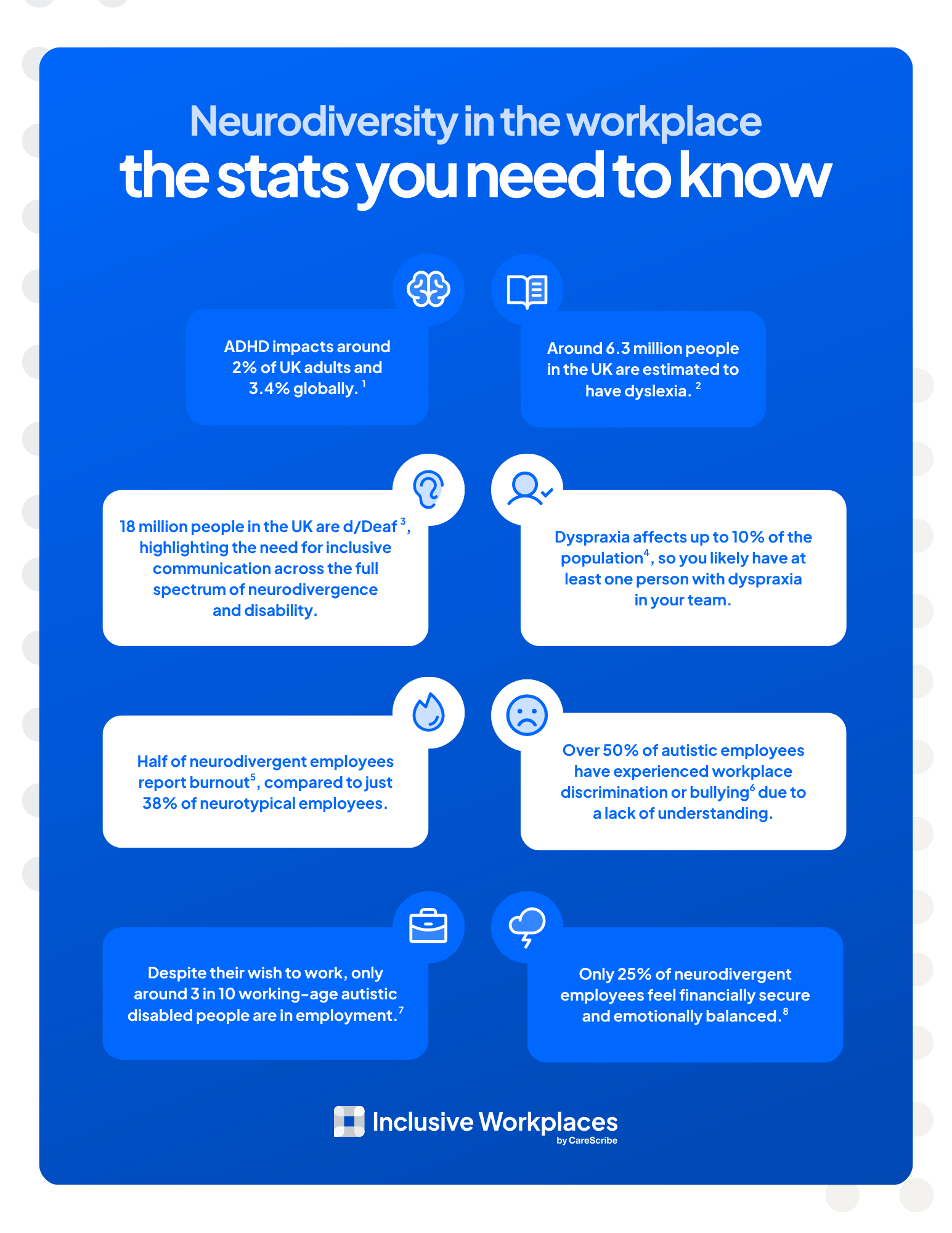Inclusive Workplaces Playbook
Proven strategies from AXA UK, Not On The High Street, and leading inclusion experts – compiled to help you build more neuroinclusive and equitable workplaces.

What’s inside the Inclusive Workplaces Playbook?
If you’ve picked up this playbook, chances are you care about inclusion, not just in theory, but in practice. You want to build a workplace where everyone feels like they truly belong, where diverse minds are supported to thrive, and where no one gets left behind. That’s exactly why we made this.
This playbook is packed with insights from people who live and breathe inclusion every day. You’ll hear from expert speakers who’ve joined our Skill Sessions webinars, professionals who’ve built inclusive cultures from the inside out, and neurodivergent employees who’ve generously shared their lived experiences with us. We’ve also included editions from our LinkedIn newsletter, Inclusive Workplaces, so you can dive deeper into the topics that matter most. (You’ll find the full list of editions at the end of the playbook.)
Think of this as a playbook you can play around with – not a rulebook or a tick-box checklist. Just a collection of ideas, strategies, and perspectives to help you do things differently (and more inclusively). Whether you’re just starting out or looking to deepen your approach, we hope what you find in here feels both practical and encouraging.
As you scroll through, you might spot insights from brilliant minds like Jess Meredith (Founder of Differing Minds), Celia Chartres-Aris (DEI expert and political analyst), Donna Stevenson (Succeed With Dyslexia Ambassador), Devon Lowndes (Neuroinclusion Consultant), Danielle Cudjoe-Michalski (Co-founder of the Neurodiversity Network) and more.
You’ll also get a behind-the-scenes look at what inclusion really looks like at companies like AXA UK and Not On The High Street, shared directly from the people driving those changes. We’re incredibly thankful to all these individuals for sharing their insider tips with our Skill Sessions community, and for allowing us to bring them to you in this playbook.
And if you enjoy what you read and are after more insights, know that our Skill Sessions community is growing. We’re still hosting those “informative, insightful and helpful (and never waffly – as one of our listeners puts it)” Skill Sessions that our audience loves.
Fancy joining the next one? We’d love to see you among us – book your free spot here.

Who’s the Inclusive Workplaces Playbook for?
While this playbook was created with people managers, DEI and HR professionals, and team leaders in mind first and foremost, it’s ultimately for anyone who’s passionate about bringing inclusion into their workplace and building teams where every individual is recognised and valued for their unique way of thinking.
While many insights in this playbook are universally applicable, our playbook is UK-focused and reflects policies, language, and workplace frameworks commonly used in the UK. Throughout the playbook, you will find examples mostly related to UK-based contexts, such as Access to Work, DSA, and case studies.
Whether you’re new to this space or looking to build on what you’ve already started, we hope you’ll find something useful, something new and maybe even something that sparks change.
And this isn’t our only resource. We’ve got a growing library of free resources to support both organisations and individuals:
- The Ultimate Guide to Neurodiversity in the Workplace eBook: Practical advice and information to help organisations of any size better support their neurodivergent people.
- The Ultimate Guide to Assistive Technology eBook: Practical advice and information to understanding, choosing, and implementing assistive technology in the workplace and in education.
- These Great Minds: Our 8-week email guide crafted for neurodivergent professionals looking to transform their work experience with the help of assistive technology.
Whenever you’re ready, get your free copy, and let’s get started.
What does inclusion really mean?
If we want a quick glimpse of what inclusion really looks like, it’s best to go straight to the source: people.
Do people around you feel welcome, safe, and heard? Do they know their background, ideas, and needs are truly valued?
Inclusive Employers defines inclusion in the workplace as “ensuring that everyone feels valued and respected as an individual“.
In practice, this entails creating transparent and equitable work settings where employees can see themselves. In meetings, for instance, an inclusive team actively promotes all voices (even the silent ones) and sets aside time to hear what everyone has to say. Fair procedures and respect for one another are valued; everyone, from interns to executives, should feel that their opinions count.
Consider these key aspects of inclusion:
- Belonging: Employees have a sense of connection; they know their perspectives add value.
- Equity: The organisation ensures fair treatment (not necessarily identical treatment) so each person’s needs are met.
- Respect: Different styles and opinions are welcomed, rather than dismissed.
In short, being inclusive means pulling people in, not pushing them out. When we say “what does inclusive mean?”, think of inclusion as making space for people to contribute. It’s about culture and behaviour – how we talk, how we design jobs, and how we coach and recognise each other. This sets the stage for a workplace where everyone’s uniqueness is an asset, not a problem.
Explore more in the playbook

“You don’t need to be from a minority demographic to support ED&I and make a difference. There’s sometimes a stigma that you need to belong to a certain group to participate, but that’s not true. My advice is: don’t let that be a blocker to getting started.”
Ben Bushby
People Experience Team Lead at Not on The High Street
Why is inclusion important for organisations?
An inclusive workplace is the proof that the business is making a smart, future-focused decision. Research consistently shows that inclusion drives better outcomes across the board.
To begin with, companies that nurture inclusion are likely to achieve better financial results. A McKinsey study found that firms in the top quartile for ethnic and racial diversity were 35% more likely to see financial returns above their national industry median. And another McKinsey report shows that companies with diverse leadership are 25% more likely to outperform their peers. These figures reflect a consistent trend: inclusion supports stronger business performance.
Inclusion also fuels innovation and problem-solving. The team as a whole may approach problems creatively when members feel comfortable offering fresh perspectives. Deloitte reported that organisations with inclusive cultures are six times more likely to be innovative and agile. In an inclusive company, employees at all levels can find sponsors or mentors who will champion their ideas. This means a brilliant idea from a junior staffer or someone in a minority group can receive the support and consideration it requires, rather than being stifled by bias or hierarchy. One study, for instance, showed that cognitively diverse teams (teams with a mix of thinking styles) solve problems 60% faster than teams without such diversity. This is a practical payoff: inclusiveness allows a diversified talent pool to reach its full potential.
Moreover, inclusive workplaces attract and retain talent – in fact, it’s a must for the new Gen Z workforce. Employees today have higher expectations than a paycheque. Over 30% of Gen Z employees prioritise diversity and inclusion for their desired workplace. They want to know that their employer shares their values.
And when inclusion is missing, they don’t hesitate to move on: over half of Gen Z and Millennial employees say they will leave their company within two years if they aren’t satisfied with its approach to inclusion. Retention matters: because turnover can be costly and disruptive. By contrast, we see that inclusive organisations benefit from higher engagement and reduced absenteeism. Employees turn into advocates, recommending their workplace to friends and communities, which helps the company to build reputation and tap into new talent pipelines.
On a human level, inclusion boosts morale and wellbeing. Studies have shown that people with disabilities or other marginalised identities report much higher happiness at work when they feel safe to be themselves. For example, one survey found employees with disabilities who disclosed their condition at work were more than twice as likely to feel happy or content on a regular basis than those who felt they had to hide it. That serves a powerful reminder: when employees don’t have to expend energy “fitting in,” they can focus on doing their work and being innovative.
What is neuroinclusion?
Neurodiversity refers to the natural variation in how people’s brains work, including conditions like autism, ADHD, dyslexia, dyspraxia, and many more cognitive styles in between. The term neuroinclusion describes the practice of ensuring these differences are not just accepted, but actively valued and supported at work.
Coined in the last 15 years, neuroinclusion is still a relatively new concept. At its core is a simple but powerful idea: Everyone’s brain functions differently – which is something to be celebrated, not corrected.
Within any team, you might find visual thinkers, hyper-focusers, or out-of-the-box problem-solvers, all of whom bring unique strengths to the table.
A neuroinclusive workplace recognises and supports this diversity. It involves acknowledging that a neurodivergent person might need, say, more time spent on tasks or less time spent multitasking, or they may contribute in ways that aren’t readily apparent in standardised performance reviews. Another sign of a neuroinclusive workplace is the offer of reasonable accommodations (like the quiet meeting pods mentioned earlier) and neurodiversity training, which means it promotes equal opportunities and understanding for people with neurodivergent conditions, such as autism or dyslexia.
In practice, this means that flexibility takes the place of expecting a single “normal” manner of working. A manager might, for instance, let an employee with autism take short breaks to recover focus, or allow someone with ADHD to use fidget toys during meetings. It also means educating the team: when team members understand how someone else’s brain in the team.
Neuroinclusion is about understanding that different support can unleash better performance. By embracing neuroinclusion, organisations tap into talents that might otherwise be overlooked.
Take a deep dive into neuroinclusion with our most popular resources
Examples of inclusion in the workplace
What does inclusion look like in action? Here are some common examples of inclusive practices from hiring through to how meetings are run.
- Diverse and inclusive hiring practices: More and more employers are seeking candidates from a wide range of backgrounds as part of their commitment to inclusive hiring. For instance, they might partner with diverse professional networks or universities, use neutral job descriptions, or hold anonymous resume reviews.A truly inclusive hiring process helps ensure candidates from under-represented groups get a fair shot at interviews. (A bonus effect: diverse hiring itself fuels innovation and financial performance by attracting varied input into products and services.)
- Reasonable adjustments during interviews: Recruiters should be proactive in offering reasonable adjustments to candidates with neurodivergent conditions, as AXA shares with us in a recent conversation. For example, candidates with ADHD can benefit from this extra time to reduce anxiety and to perform at their best. AXA provides the option for additional time during assessments or adjustments to the assessment format itself.
- Meetings that are inclusive: An inclusive team makes sure that all opinions are heard during a meeting. To give employees who are introverted or neurodivergent time to be ready, they may begin by communicating the agenda beforehand. During the meeting, the chair can invite input in turn, rather than only calling on the most outspoken people. Virtual meetings can also be run inclusively – for instance, allowing camera-off participation or text-chat options, since some team members may process information differently. Allowing fidgeting or quiet doodling in their seats can also help employees focus. Yes, creativity sometimes involves leg-shaking or tapping a pen.
- Accessible tools and spaces: Inclusive workplaces often make both their physical and digital environments accessible for their employees. This could mean providing software that reads material aloud, creating ramps and adaptable workstations, or accessible communication options like sign-language interpreters.
- Flexible work: Inclusion recognises that “one-size-fits-all” work arrangements don’t work for everyone. An inclusive employer might offer flexible hours or remote work options. This helps caregivers, those with long-term medical illnesses, and neurodivergent employees who may have unique needs (e.g. timed breaks to focus, or the ability to adjust lighting and sound at home). Flexible work practices show trust and respect for life outside of work, and management’s concern for individual circumstances.
- Celebrating differences: Simple actions like marking cultural or religious holidays (or even awareness days) can demonstrate respect. For instance, allowing flexible scheduling around religious observances, or hosting briefings during Diwali, Pride Month, or Ramadan. These gestures signal that differences aren’t just tolerated – they’re valued.
- Employee Resource Groups (ERGs) and other support networks: Many inclusive companies have voluntary staff groups where people with shared identities (e.g. women, LGBTQ+, different ethnic groups, or neurodivergent colleagues) connect, advise management on issues, and support one another. Alongside this, allyship programs encourage employees from majority groups to champion inclusion. These networks help employees feel they belong and that the organisation sees their experiences.
- Transparent communication and feedback: Inclusive organisations openly share information and decisions. They ask for employee feedback (through surveys or focus groups) and act on it. For example, leaders might share pay-range data to ensure fairness, or hold “town hall” Q&As where any employee can pose questions. Soliciting honest feedback also helps catch exclusionary issues early.
Real-life case studies of inclusion in the workplace
AXA’s Accessibility Concierge Service
We often hear that inclusion is a journey and AXA UK is showing what it looks like to take real steps forward. Their Accessibility Concierge Service is a brilliant example of inclusive recruitment being brought to life. Developed by Talent Acquisition Partner Jen Manuel and supported by the broader accessibility team, this initiative provides a personalised, proactive support system for disabled and neurodivergent job applicants. And it’s fundamentally changing the candidate experience. Download our playbook to see why AXA’s Accessibility Concierge Service works and learn more about its impact.
Diversity Working Group at Not On The High Street
At Not On The High Street (NOTHS), inclusion is a core part of how the business operates day to day. One of the most compelling examples of this is their Diversity Working Group, a cross-functional team that brings together champions from across departments to embed equity, diversity and inclusion (ED&I) into the fabric of the company.
Unlike initiatives that sit solely with HR, the Diversity Working Group at NOTHS distributes responsibility for inclusion throughout the business. Employees from Legal, People Experience, and beyond step into active roles, helping to shape the company culture and bring inclusive practices to life. Download our playbook to see why Diversity Working Group at Not On The High Street works and learn more about its impact.
How to build inclusive workplaces for neurodivergent staff
“Awareness changes the world.” That was the message from neurodiversity expert Donna Stevenson during our recent conversation and it’s one that continues to resonate across our growing community of inclusion advocates.
As more organisations aim to build truly inclusive workplaces, neurodiversity is finally gaining attention. But there’s still a long way to go. Just 44% of UK organisations have neuroinclusion strategies in place and actively embed inclusion into their employee benefits, according to City & Guilds’ 2024 Neurodiversity Index. WTW’s Emerging Trends in Healthcare Survey echoes this number: just 1 in 5 employers have implemented policies to support neurodivergent staff. Another 24% plan to, but in the meantime, many neurodivergent employees are left without the support they need. The same survey shows neurodivergent employees are asking for better mental health benefits (39%) and more workplace flexibility (38%). There’s clear demand but unfortunately, not enough action.
On the other hand, the organisations that do are reaping the rewards:
- Neuroinclusive companies are twice as likely to exceed financial targets and three times more likely to outperform their competition, according to Deloitte.
- Teams that include and support neurodivergent employees show up to 30% higher productivity.
- McKinsey’s landmark diversity report highlights how neurodivergent leaders bring unique strengths that drive innovation and long-term growth.
So how can you make this real in your workplace? Let’s break down the core pillars to focus on.
1. Understand the current barriers for neurodivergent talent
Neurodivergent people (people with autism, dyslexia, ADHD, or other conditions) often face systemic challenges at every stage of working life. From getting in the door to staying and thriving, the barriers are real, persistent, and often invisible to those not affected by them.
- Workplace Barriers
- Disclosure and Masking
- The Return-to-Office Challenge
- Unaware of Rights
- Hiring Biases
Get your free copy to explore more.
2. Create a solid EDI strategy
Inclusive change begins with planning and listening. We suggest all HR and inclusion leaders to develop an EDI strategy that explicitly prioritises neurodiversity. This means setting goals (e.g., improving hiring or retention of neurodivergent people) and incorporating the ideas, and the feedback of your neurodivergent team members in the planning process.

“Move away from that, nice-to-have, warm, fuzzy notion of neuro-inclusion. See and believe in the commercial application and benefits for your company because they’re enormous.”
Dr Richard Purcell
Founder and Director of CareScribe
3. Embed inclusive culture through training
Train leaders specifically. Leadership behaviour sets the tone: aware of bias, and encourage diverse ideas. Deloitte Insights shares that leaders’ actions send powerful messages. For instance, an inclusive leader might publicly credit a junior employee’s idea in a meeting, or make it a point to invite remote colleagues into key discussions. Managers should also be trained on how to have conversations about needs. If a staff member says, “I struggle with noisy rooms,” the manager should respond with interest (not defensiveness) and help find a solution. Embedding inclusion into leadership development ensures these practices become second nature.
Get your free copy to explore more.
4.Use inclusive language
Language shapes culture and the words we use at work really matter. One simple but powerful way to support neuroinclusion is by using language that’s respectful, accurate, and led by the preferences of neurodivergent people themselves.
Start by putting people first. Many neurodivergent individuals prefer person-first language – for example, saying “people with dyslexia” instead of “dyslexics”. In fact, in one recent survey, respondents with ADHD, dyspraxia, and dyslexia favoured person-first language37 by 88.9%, 65.5%, and 71% respectively. Another key finding? Most respondents preferred the term neurodivergence over disorder or condition – terms that can carry clinical or deficit-based connotations.
Get your free copy to explore more.
5. Build psychological safety at work
Organisations (especially leaders) need to foster a team culture of flexibility and understanding. Say out loud that accommodations are normal and accepted. According to Harvard Business Review, disclosing aspects of identity makes for a happier workforce. For example, employees with disabilities who disclose to most people they interact with are more than twice as likely to feel regularly happy or content at work than employees who have not disclosed to anyone (65% versus 27%).
Get your free copy to explore more.
6. Create inclusive teams and environments
An inclusive culture doesn’t happen overnight, it’s built moment by moment, team by team. It starts with something as simple (and as overlooked) as the environment itself.
Start with the space around you. Many neurodivergent people are sensitive to sensory input, so small tweaks to your physical workspace can make a big difference. Think: turning off flickering lights, switching to softer lighting, avoiding overpowering scents, and minimising distractions where possible. Noise-cancelling headphones can be a game-changer, and natural light is always a plus.
Assistive technology (AT) is one of the most practical ways to remove barriers and yet it’s vastly underused. Despite its benefits, only 3–4% of employees with disabilities report receiving assistive accommodations which is a massive gap. There are countless tools designed to support focus, organisation, and communication especially helpful for those with ADHD, dyslexia, or anxiety. Here are just a few:
- Task planners (like Asana or Todoist) to break big goals into manageable steps
- Text-to-speech tools to support reading and comprehension
- Speech-to-text/dictation software like TalkType – perfect for fast, accurate, and low-stress writing
- Note-taking apps like Caption.Ed, which offer transcripts, summaries, and more
- Ambient noise apps or fidget-friendly tools to boost focus in overstimulating environments
Get your free copy to explore more.
7. Promote equal opportunities
Inclusion requires that neurodivergent staff have the same opportunities as anyone else – just with supports as needed. This starts at recruitment. Use inclusive hiring methods: for example, give candidates options for how to take assessments (more time, or break them into parts) and allow creative audition tasks. Conduct interviews in a comfortable, low-pressure setting (avoid surprises or rapid-fire questioning). You might also involve neurodivergent staff in designing your hiring process to ensure it’s fair.
Useful links
Here’re the list of Inclusive Workplaces editions included in this playbook:
- Celebrating Autism as a Strength in the Workplace
- How Support Drives Success for Employees with Dyspraxia: Insights from Lived Experiences
- Building a Neuro-Inclusive Culture in the Workplace Through Language
- Championing Mental Health for Neurodivergent Talent in the Workplace
- Practical Strategies for Navigating and Supporting ADHD in the Workplace
- How Assistive Technology Benefits Your Organisation and Neurodivergent Talent
- Inclusive Recruitment: Lessons from AXA UK
- Leadership and Neuroinclusion: Your Top Questions Answered
- Can ED&I Working Groups Drive Real Change? Lessons from Not On The High Street
- The Return-to-Office Challenge: Three Essential Strategies for Inclusive Transitions
- Dyslexia in Crisis? How Organisations Must Respond to the Shifting Landscape of 2025
- How Are US Changes Affecting UK DEI? Strategies to Navigate the Shifting Landscape





